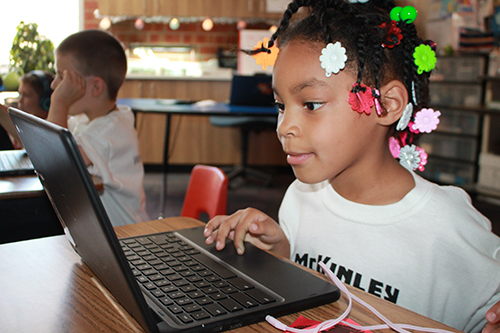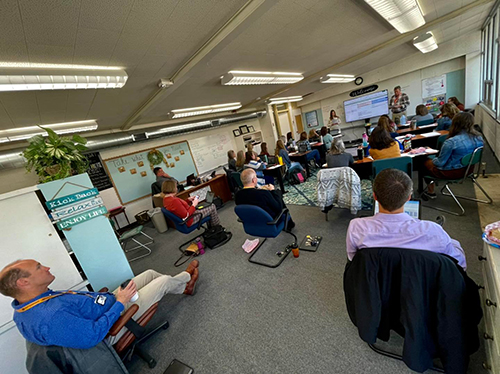At the center of Cañon City School District's logo is its motto, "Learning for Life," emblazoned over a silhouette of the Rocky Mountains. That motto, says Superintendent Adam Hartman, represents the commitment of educators across all eight schools to providing their students with the tools and skills they need to be successful in the world they’re living in today and long after their time at Cañon City Schools. Technology in the classroom plays a major role in that.
“One of the things that we are proud of is that we say we are future focused and we want kids to have innovative opportunities and learning,” said Adam. “But we also want our kids to have influence on what the world looks like. We wanted our kids to be creators and not just receivers. We recognized that in order to give our kids a world-class education, we needed to better augment our technology experience for them.”
Before they could start implementing edtech, Cañon City officials needed to form a clear vision about how these tools, from the actual digital devices to learning management systems and online content, were going to be used. They also needed to ensure their staff was trained and supported on how to use those tools most effectively. Here’s their story about how that vision has guided them through this journey and how thoughtful planning and a partner like Savvas helped them bring it to life in the classroom.
Introducing EdTech to Cañon City
In the 2014-2015 school year, Cañon City School District was behind in test scores and academic performance. Its administration knew that in order to improve student outcomes, they needed a change. That change began with implementing new, rigorous, standards-aligned solutions that offered interactive, engaging, and personalized learning experiences. The district also reimagined a school environment that gave its students access to a world-class, future-focused education. Robust educational technology, whether it’s the tools teachers use to teach or the tools students use to learn, would be critical to that.
“We have not only an opportunity, but a responsibility to continue to think about things like job markets, what’s happening in the world beyond school, what’s happening in countries beyond just ours,” said Adam. “And that we’re providing for kids so that they can pursue whatever they’d like to do. So we are very much futurists. We try to be very thoughtful about what trends we’re seeing in higher education and in labor, so that we’re bringing those technologies into our schools.”
They formed a committee of teachers and administrators to plan how they could bring the right technology in, and then use that technology to help their students become leaders, innovators and creators after they leave school — or as the district calls them: “framers of the future.”
How Savvas Solutions Are Meeting Teacher and Student Needs
The committee created three instructional pillars that would help each teacher to be on the same page when it came to purposefully using any technology in their instruction. All educators would align their instruction to these guiding principles, ensuring that they are always supporting students’ learning by using technology intentionally and recognizing when “paper and pencil” might be best suited to teach a lesson.
“There's so much [technology] out there that it’s pushed schools to look at the question: ‘How much is too much?’” asked Adam. “And how much of it is supporting the learning? It’s because of that, our district, even long before the pandemic, had developed three instructional pillars. We needed to be really thoughtful so that we didn’t end up using it for the purpose of babysitting, or gamification or simply filling time.”
There need to be a balance between technology use in the classroom and other non-tech experiences as well. We will continue to strive to provide modern tech experiences with our students, as long as the technology is the right tool for the instruction.
The three pillars the committee developed are:
- Learning Target: Throughout each lesson, teachers communicate an appropriately rigorous and relevant learning target.
- Engagement: Teachers consistently make use of strategies that actively engage all students in achieving the daily learning target.
- Assessment: Teachers use a variety of effective formative and summative assessments to measure student learning and guide instruction.
Middle school technology teacher Tanna Miles says that the pillars have been helpful in finding that balance between technology and real-life application.
“It is big in our district to not just give students the tools they need educationally, but to also make sure they’re grounded in who they are, that they have confidence in their abilities, and that they’re able to make decisions and think critically,” she said. “All of these components work together to shape a student into a more-productive citizen.”
Where They Landed with Edtech
After extensive research and discussion, Cañon City officials adopted Google Classroom for their Learning Management System (LMS) at the elementary level and Schoology at the secondary level. Savvas Realize, the first publisher platform to become a Google for Education partner and an industry leader in seamless integration with the edtech tools schools and districts use most, enables Cañon City teachers to digitally access a wide variety of Savvas solutions, such as enVisionMath2.0, myPerspectives, iLitELL, and Miller & Levine Biology.
 “The Savvas platform allows for instruction and remediation, as well as an interactive learning experience for our kids,” said Dan Coppa, educational technology and instructional coaching coordinator at Cañon City. “This is true in math as well as in middle school ELA. The fact that we’re able to use multiple resources from one vendor also benefits us in terms of all teachers having familiarity with the Realize platform.”
“The Savvas platform allows for instruction and remediation, as well as an interactive learning experience for our kids,” said Dan Coppa, educational technology and instructional coaching coordinator at Cañon City. “This is true in math as well as in middle school ELA. The fact that we’re able to use multiple resources from one vendor also benefits us in terms of all teachers having familiarity with the Realize platform.”
According to Dan, the integration process with Savvas Realize has gone very smoothly. The district’s data specialist, who was in charge of the process, has been able to easily set up a recurring nightly sync with all of their student information.
“He’s not had any major issues but whenever we do run into a hiccup here or there he has had quick responses from the support team at Savvas,” Dan said. “So he is thankful for that. That has been a very positive experience throughout our district with the onboarding process. It has been seamless in getting everything set up. Savvas has been a solid and dependable partner in providing our students with digital learning opportunities.”
Training Staff to Use the EdTech
It was very important to the committee that the district staff was not only well trained in the use of its educational technology, but they also understood that technology is a tool to help them reach student learning goals — not a replacement for high-quality human interactions.
“That was one of our main focus points,” said Dan, who was a member of the committee. “Trying to train teachers and school staff that the technology is a tool, and sometimes it’s the appropriate tool for the job, and sometimes it’s not, and not to rely on it for everything you’re doing.”
 Cañon City educators have also received both in-person and virtual training for the two major Savvas products they’re using: myPerspectives at the middle school ELA level and enVisionmath2.0 at the elementary and middle school level. “We’ve had great experience with the training of staff, and also how we can help our staff use the digital components within them.”
Cañon City educators have also received both in-person and virtual training for the two major Savvas products they’re using: myPerspectives at the middle school ELA level and enVisionmath2.0 at the elementary and middle school level. “We’ve had great experience with the training of staff, and also how we can help our staff use the digital components within them.”
Now, Dan and his team provide their own edtech professional development to Cañon City’s teachers. Their training is based on the SAMR (substitution, augmentation, modification, and redefinition) model, a framework created in 2010 by education researcher Ruben Puentedura that categorizes four different degrees of classroom technology assimilation. “Part of the SAMR model is understanding when to use technology and how to leverage it in different ways to accomplish different tasks,” he said.
The Future of Edtech at Cañon City
Part of the district’s edtech journey also focused on exposing students to technologies used in industries so that they would be successful in their careers. As part of this initiative, Cañon City’s educators developed what they called the “Portrait of a Graduate.” They did this in order to remain “future focused,” and ensure they lived up to their commitment to provide their students with the skills, traits, and tools they would need to be successful in any occupation they pursue after graduation.
“We have always thought it was important to prepare students for the world they will be living in,” said fifth grade teacher, Renee Watters. “Not how the world currently is.”